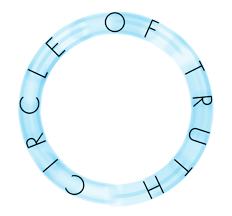Truth. It’s a simple enough word – one syllable, five letters. Intuitively we think we know what it means, what truth is. Truth is the neighbor of reality, seemingly incontrovertible. But is truth really a constant? Is it universal? Does truth transcend time, place, culture, race or circumstance? Is your truth the same as my truth?
The dictionary describes truth as: 1. Conformity to fact or actuality. 2. A statement proven to be or accepted as true. 3. Sincerity; integrity. 4. Fidelity to an original or standard. 5a. Reality; actuality. 5b. That which is considered to be the supreme reality and to have the ultimate meaning and value of existence.
Conformity? Accepted? Reality? Who decides what is real, how truth is proven? Conformity makes truth sound more like quantified popular opinion than constant. Is it really truth that we uncover, or is it only our perception of truth that we see? It’s been said that a lie, repeated enough times, becomes the truth. Can we know the truth or are we limited to merely believe what is true? Can we trust truth?
Many of us experienced the elusiveness of truth when we played the rumor game, what some called telephone. In my case it was in Mrs. Pew’s second grade class. We sat in desks arranged in the customary neat rows, about 30 of us. Mrs. Pew whispered something into the ear of the student in the first seat of the front row. That truth was then to be conveyed to the person behind her, and the message zigzagged back and forth, up and down the rows to the last seat in the last row. That person then announced what they had heard from the one before them. When Mrs. Pew revealed to us what she had started around the room, it of course in no way had anything to do with how it ended up. We all laughed.
Mrs. Pew was trying to teach us a lesson, one I’m not sure that any of use knew the importance of – or perhaps even learned. I wondered how my teacher’s message had gotten so fouled up. Was it a case of mere semantics, differences in connotation, of faulty encoding and decoding? Or had one or more of my classmates deliberately changed the message they heard in order to send the truth off in some other direction?
Truth, if it actually exists, is dangerous. “The truth hurts.” Truth can do more than hurt. Truth has become a form of currency – withheld, saved, revealed, spent. “Do you solemnly swear that you will tell the truth, the whole truth, and nothing but the truth, so help you God?” We’ve heard these words in just about every courtroom movie and TV show we’ve ever watched. How can anyone swear to know the whole truth? Based upon what? Are we omniscient beings, seeing all, knowing all? Is anything less than the whole truth really the truth at all? Is a half-truth even fractionally true?
As the designer of this catalog I’ve had the unique opportunity of seeing the Circle of Truth unfold. I’ve seen the paintings come in and go out, I’ve read each and every artist’s essay. 49 intrepid creative souls, bound by risk and courage. In their essays almost every artist expressed the fear they faced in trying to discover the truth in the painting to which they were charged with responding. The nature of that truth was unrevealed to them. Was it a color, a shape, a technique? Was the truth serious or silly? There are sequences of paintings where one would assume that three or four artists might have created their works in the same room at the same time. Their truths are overtly evident and profoundly expressed. At other junctures, it’s apparent that the truth took a left turn, as it must have in Mrs. Pew’s class so many years before. In those cases, was truth subverted by rebellious will, playful caprice, inability to comprehend the “visiting painting,” or their unwillingness to take the project seriously? No matter the response each artist created his or her own truth.
Whatever truth, or truths, the Circle holds will be subject to the bias, sophistication and sensitivity of the viewer. The viewer is the final arbiter. As in all art, that is the way it should be.
– Randy Hipke
